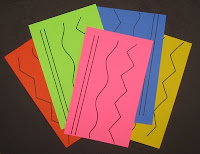 The collages pictured here were done by first grade students. The directions were to use:
The collages pictured here were done by first grade students. The directions were to use:- one circle
- two lines
- three different triangles
- four colors
Now that seems pretty simple, but the execution has some tricky parts. Many students are confused by the direction to use four colors, because they only use three shapes (circle, line, triangle) but end up with six parts. I try to ask them questions as they are working: "How many colors do you have here?" "How many colors do you need?" "Could you trade something?" I try really, really hard not to just tell a student to, for example, trade "this orange triangle for a green one" or some such thing, because I don't want to take away the opportunity for students to work through the problem on their own.
 I demonstrate how to cut lines from the edge of a straight piece of paper, and how to cut triangles by cutting the corner off a piece of paper. With table groups, everyone gets one 9x12 sheet of black paper for the background, and I put a selection of 6x9 pieces of construction paper in the middle of the table, just one sheet of each color so they have to share the colored paper. This has the added benefit of preventing two or more students from using all the same colors for their designs.
I demonstrate how to cut lines from the edge of a straight piece of paper, and how to cut triangles by cutting the corner off a piece of paper. With table groups, everyone gets one 9x12 sheet of black paper for the background, and I put a selection of 6x9 pieces of construction paper in the middle of the table, just one sheet of each color so they have to share the colored paper. This has the added benefit of preventing two or more students from using all the same colors for their designs.I have done geometric shape collages with students in all grade levels. With Kindergartners, the directions are simpler, and there are less shapes involved. With fifth grade students, the directions are more complex, including more sophisticated geometric terms, and I might throw in a fraction element. I have them use, for example, three different types of triangles, four different quadrilaterals, five colors or less, and to attempt to cover approximately half the area of the paper with their shapes. Depending on the grade level, this activity can be a way for students to demonstrate their knowledge of some geometry vocabulary. Best of all, though, they are great fun to look at.
















